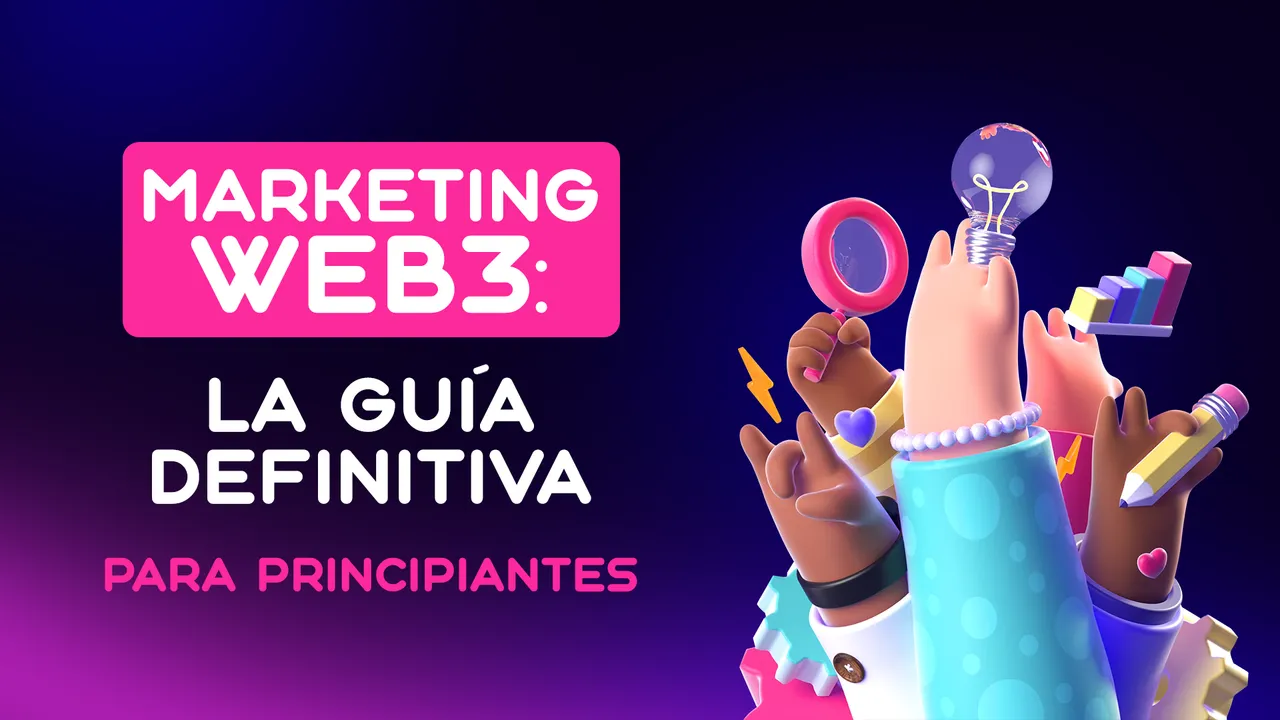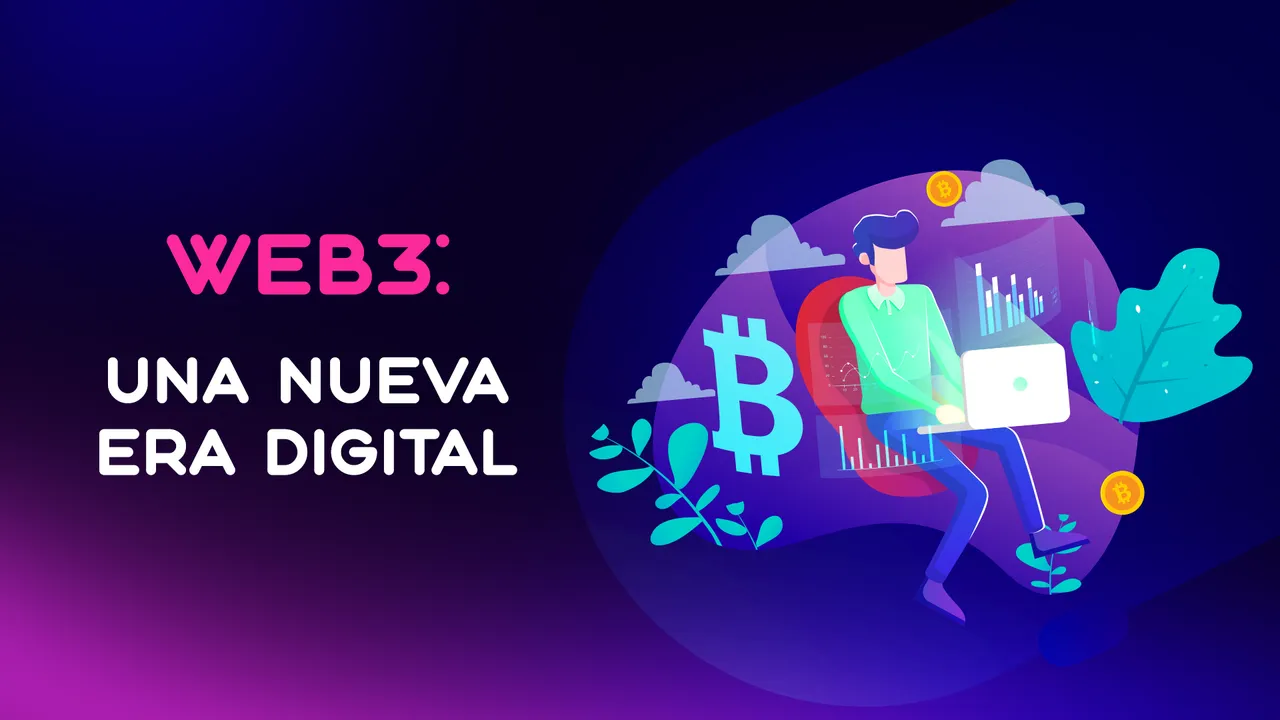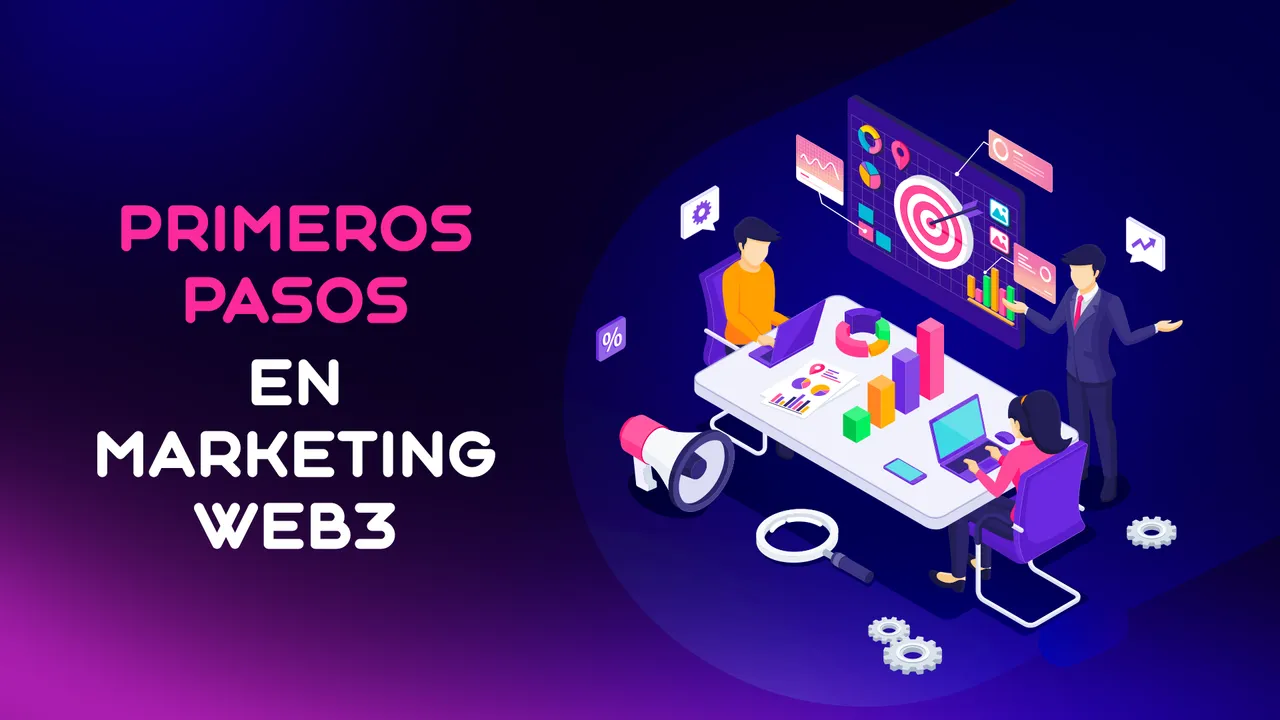
¿Te ha pasado que buscas algo en Internet y, de repente, los anuncios te siguen a todas partes?
Abres una red social o navegas por cualquier página, y ahí están otra vez… Como si las marcas leyeran tu mente (o más bien, tus datos).
Pero, ¿y si en el futuro del marketing fueras tú quien elige qué marcas apoyar e incluso te pagaran por ello?
En la Web3, es posible, pues el marketing deja de ser intrusivo y se convierte en una experiencia de valor real.
En esta guía, aprenderás:
- ¿Qué es Web3?
- ¿Por qué está cambiando el juego? y
- ¿Cómo puedes empezar a aplicar esta tecnología en tus estrategias de marketing?
¿De qué va Web3?
Si Internet fuera una película, Web1 sería la época del cine mudo, Web2 sería Hollywood con efectos especiales, y Web3… bueno, Web3 te convierte en el director, productor y dueño de la película.
Veamos cómo es que llegamos a Web3:
- WEB1: Las personas sólo podían leer la información pero no interactuar con ella. (Existían los blogs y portales de noticias)
- WEB2: Llegaron las redes sociales y plataformas como YouTube donde los usuarios empezaron a subir contenido. Esto hizo que Internet fuera más interactivo, pero con un problema: nuestros datos pasaron a estar en manos de otros (empresas).
- WEB3: Aquí es dónde todo cambia, las personas poseen sus datos, contenido y activos digitales gracias a la tecnología blockchain. Intermediarios como Google o Facebook, ya no son necesarios. Es un Internet donde tú tienes el control.

Pilares de Web3: Descentralización, Blockchain y Tokens
Descentralización
Los datos están en una red distribuida (blockchain), lo que significa que nadie puede censurarlos ni modificarlos sin consenso.Blockchain
Es como un gran libro de contabilidad digital donde todas las transacciones y datos quedan registrados de forma segura y transparente.Criptomonedas y Tokens
En lugar de depender de anuncios o suscripciones, en Web3 las marcas pueden crear sus propios tokens y recompensar a los usuarios por interactuar con ellas.
En pocas palabras, en Web3 el Internet es un espacio más abierto, transparente y participativo. Los usuarios son dueños de su contenido y parte activa de las marcas que consumen.
Esto cambia por completo las reglas del marketing… y en el siguiente punto veremos cómo los marketers pueden aprovechar esta revolución.
¿Por qué el Marketing en Web3 es diferente?
Para entender su impacto, primero recordemos que el marketing consiste en generar valor, conectar con las personas y adaptarse a sus necesidades.
Antes del Internet, las marcas usaban medios como la radio, la prensa y la televisión para llegar a su público, pero la comunicación era de una sola vía. La publicidad era masiva y poco precisa.
Con Internet, todo cambió. Las redes sociales y el email marketing permitieron una conexión directa con los clientes, haciendo que la publicidad fuera más personalizada. Plataformas como Facebook e Instagram ayudaron a construir comunidades en torno a las marcas.
Luego llegó la inteligencia artificial y el Big Data, permitiendo anuncios en tiempo real y atención automatizada. Sin embargo, el control de los datos por parte de grandes empresas ha generado preocupaciones, impulsando nuevas alternativas más descentralizadas.
Ahora, imagina un marketing donde los usuarios tienen el control, donde las marcas pueden construir relaciones directas sin intermediarios y donde la comunidad no solo participa, sino que también obtiene beneficios.
Eso es Marketing en Web3.
La comunidad es la clave
En Web3, el usuario deja de ser un simple comprador y se convierte en parte de la marca. Esto significa que los clientes pueden:
- Tener voz y voto en las decisiones de la marca (a través de DAOs).
- Recibir recompensas en tokens por participar en campañas de marketing.
- Tener acceso a productos o eventos exclusivos a través de NFTs.
Ahora veamos cómo puedes empezar a involucrarte.

Consejos para Empezar en el Marketing Web3
Web3 y la blockchain están cambiando las reglas del marketing. Pero, ¿cómo puedes dar el primer paso sin sentirte abrumado por todos los tecnicismos?
Aquí tienes un plan simple y práctico para comenzar en Web3 sin necesidad de ser un experto en blockchain o criptomonedas.
- Paso 1: Crea una Wallet Web3 y explora el ecosistema
Antes de pensar en estrategias de marketing, necesitas experimentar cómo funciona Web3 desde la perspectiva de un usuario. - Paso 2: Únete a comunidades Web3 y sumérgete en la conversación
Web3 se basa en la comunidad, así que la mejor manera de aprender es participando en comunidades activas. - Paso 3: Aprende sobre NFTs y cómo se usan en Marketing
Los NFTs no son solo imágenes de monos costosos, sino pueden ser membresías exclusivas, tickets para eventos, certificados digitales y más. - Paso 4: Experimenta con Tokens y la Economía de Incentivos
Una de las grandes innovaciones es que los usuarios pueden ser recompensados por interactuar con una marca. En lugar de solo dar "me gusta" a una publicación, pueden recibir tokens con valor real.
El Futuro del Marketing está en Web3
Esto no es solo una moda, sino un cambio real en la forma en que las marcas y los consumidores se conectan.
La descentralización, la transparencia y la participación activa de la comunidad están redefiniendo el juego, permitiendo a los marketers construir relaciones más auténticas y valiosas con su audiencia.
Las marcas que adopten estas nuevas estrategias primero tendrán una ventaja competitiva en la era digital.
💬 ¿Qué parte del marketing Web3 te emociona más? ¿Tienes dudas o quieres aprender más?
¡Déjanos tu comentario y hablemos sobre el futuro del marketing!
.
Fuentes y Bibliografía:
1️⃣ Ethereum Foundation (2023). What is Web3?
2️⃣ Gavin Wood (2014). Web3: A New Decentralized Internet Vision.
3️⃣ Andreessen Horowitz (a16z) (2022). Web3 and the Future of the Internet.
4️⃣ Chris Dixon (2021). The Web3 Paradigm Shift.
5️⃣ Vitalik Buterin (2021). Decentralization and the Future of Digital Interaction.
6️⃣ CoinDesk (2023). Web3 Explained: The Next Evolution of the Internet.
7️⃣ Andreessen Horowitz (a16z) (2022). Web3 and the Future of Marketing.
8️⃣ Bankless DAO (2023). How to Join a Web3 Community.
Images created by our Design Team using Photoshop.
English Version
Have you ever been looking for something on the Internet and suddenly, ads follow you everywhere?
You open a social network or browse any page, and there they are again... As if brands were reading your mind (or rather, your data).
But what if, in the future of marketing, you were the one who chose which brands to support and even got paid for it?
In Web3, it's possible, as marketing stops being intrusive and becomes an experience of real value.
In this guide, you will learn:
- What is Web3?
- Why it's changing the game, and
- How can you start applying this technology to your marketing strategies?
What is Web3 about?
If the Internet were a movie, Web1 would be the silent era, Web2 would be Hollywood with special effects, and Web3... well, Web3 makes you the director, producer and owner of the movie.
Let's see how we got to Web3:
- WEB1 : People could only read the information but not interact with it (there were blogs and news portals).
- WEB2: Social networks and platforms like YouTube came along where users started to upload content. This made the Internet more interactive, but with a problem: our data became in the hands of others (companies).
- WEB3: This is where everything changes, people own their data, content and digital assets thanks to blockchain technology. Intermediaries like Google or Facebook are no longer necessary. It's an Internet where you are in control.
Pillars of Web3: Decentralization, Blockchain and Tokens.
Decentralisation.
Data is in a distributed network (blockchain), which means that no one can censor or modify it without consensus.Blockchain.
It is like a big digital ledger where all transactions and data are recorded securely and transparently.Cryptocurrencies and tokens.
Instead of relying on ads or subscriptions, on Web3 brands can create their own tokens and reward users for interacting with them.
Simply put, on Web3 the Internet is a more open, transparent and participatory space. Users own their content and are an active part of the brands they consume.
This completely changes the rules of marketing... and in the next section we will see how marketers can take advantage of this revolution.
Why is Web3 Marketing different?
To understand its impact, let's first remember that marketing is about generating value, connecting with people and adapting to their needs.
Before the Internet, brands used media such as radio, print and television to reach their audiences, but communication was one-way. Advertising was massive and imprecise.
With the Internet, everything changed. Social media and email marketing allowed a direct connection with customers, making advertising more personalised. Platforms like Facebook and Instagram helped build communities around brands.
Then came artificial intelligence and Big Data, enabling real-time ads and automated attention. However, the control of data by big business has raised concerns, driving new, more decentralised alternatives.
Now, imagine a marketing where users are in control, where brands can build direct relationships without intermediaries and where the community not only participates, but also benefits.
That's Web3 Marketing.
Community is the key
In Web3, the user stops being a simple buyer and becomes part of the brand. This means that customers can:
- Have a say in brand decisions (through DAOs).
- Receive token rewards for participating in marketing campaigns.
- Have access to exclusive products or events through NFTs.
Now let's look at how you can start getting involved.
Tips to Get Started in Web3 Marketing
Web3 and blockchain are changing the rules of marketing. But how can you take the first step without being overwhelmed by all the technicalities?
Here's a simple and practical plan to get started in Web3 without needing to be an expert in blockchain or cryptocurrencies.
- Step 1: Create a Web3 Wallet and explore the ecosystem
Before thinking about marketing strategies, you need to experience how Web3 works from a user's perspective. - Step 2: Join Web3 communities and immerse yourself in the conversation
Web3 is community-based, so the best way to learn is by participating in active communities. - Step 3: Learn about NFTs and how they are used in marketing.
NFTs are not just images of expensive monkeys, but can be exclusive memberships, event tickets, digital certificates and more. - Step 4: Experiment with Tokens and the Incentive Economy
One of the big innovations is that users can be rewarded for interacting with a brand. Instead of just ‘liking’ a post, they can receive tokens with real value.
The Future of Marketing is on the Web3
This is not just a fad, but a real shift in the way brands and consumers connect.
Decentralisation, transparency and active community participation are redefining the game, allowing marketers to build more authentic and valuable relationships with their audience.
Brands that embrace these new strategies first will have a competitive advantage in the digital age.
💬 Which part of Web3 marketing excites you the most? Do you have questions or want to learn more?
Leave us a comment and let's talk about the future of marketing!
.
Sources and Bibliography:
1️⃣ Ethereum Foundation (2023) What is Web3?
2️⃣ Gavin Wood (2014). Web3: A New Decentralized Internet Vision
3️⃣ Andreessen Horowitz (a16z) (2022). Web3 and the Future of the Internet.
4️⃣ Chris Dixon (2021). The Web3 Paradigm Shift.
5️⃣ Vitalik Buterin (2021). Decentralization and the Future of Digital Interaction.
6️⃣ CoinDesk (2023). Web3 Explained: The Next Evolution of the Internet.
7️⃣ Andreessen Horowitz (a16z) (2022). Web3 and the Future of Marketing.
8️⃣ Bankless DAO (2023). How to Join a Web3 Community.
Images created by our Design Team using Photoshop.Translated with DeepL.com